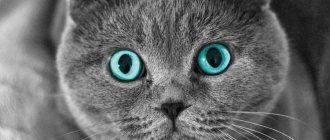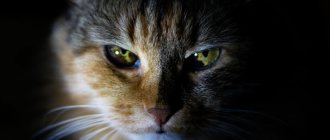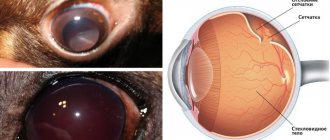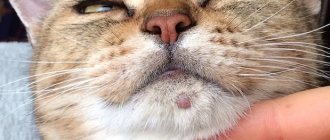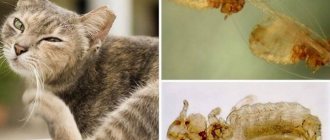Save article:
Calcivirosis in cats is considered a serious viral disease that is widespread. The disease affects the respiratory system. Complications of the disease can include pneumonia and arthritis. The tongue, mouth and nose are also often affected.
The virus is transmitted mainly through contact by sneezing from a sick cat to a healthy one. The disease is insidious: sometimes it hides and goes into the carrier stage, but stress manifests it again. To protect against calcivirus, vaccination can be performed, but it will not provide 100% protection, but will only alleviate the symptoms of the disease.
Causes of calicivirus in cats
The development of calicivirus is caused by strains of a cubic RNA virus - Feline Calicivirus.
Calicivirus in cats is an infectious pathology of viral origin.
The pathogen affects the entire cat family, regardless of age and breed; young animals and animals under 2 years of age show the greatest sensitivity to infection.
The microorganism is stable in the external environment: outside the host it can exist for up to 10 days, which leads to the rapid spread of the disease.
Important! Caliciviruses are difficult to inactivate with many disinfectants, but they are destroyed quickly when exposed to bleach.
The disease often develops during cold periods, as the body's natural resistance decreases.
Other factors of infection are:
- lack of vaccination;
- crowded keeping of animals in nurseries;
- insufficient ventilation in the room.
When cats are kept in groups, the disease is quickly transmitted and periodically manifests itself in outbreaks of infection.
Attention! The FCV virion does not have strong activity, and the pathology is often hidden. But when other infectious agents (mycoplasmas, viruses or bacteria) join in, the breeder can lose up to 80% of valuable animals.
Symptoms of calicivirus in cats
Having penetrated the body, microorganisms actively multiply on the mucous membrane of the cat’s mouth, in the submandibular lymph nodes and the epithelium of the tonsil crypts.
Symptoms of calcivirosis can appear in any combination
The incubation period is determined by the resistance of the immune system and the virulence of the strain; it generally lasts 2-10 days, sometimes extending to 20 days.
The disease is manifested by an increase in temperature to 40.5 C°, fever is observed for 3 or 4 days.
Symptoms of the disease depend on age and immune status and are characterized by:
- depressed state of the animal;
- refusal of food;
- coughing and sneezing;
- discharge from the nasal cavity and eyes;
- the appearance of small bubbles up to 1 mm on the mucous membranes of the mouth: on the sides of the tongue, on the palate;
- drooling.
Be sure to read:
Hemobartonellosis in cats: what is it, causes, symptoms and methods of treatment, prevention
When affected by certain types of virions in cats, arthritis develops against a background of severe symptoms.
Gradually, the bubble elements spread to the nostrils. Over time, the formations burst, transform into erosions, which gradually deepen and ulcerate.
Important! Certain strains of calicivirus infection are able to penetrate the lungs of animals. They multiply in the epithelial cells lining the alveoli, causing necrosis and the formation of pneumonia.
The duration of acute symptoms is from 1 to 4 weeks, the surface of the mucous epithelium is gradually regenerated, and if left untreated, 30% of animals die.
Oral ulcers are the first sign of calcivirosis
In kittens up to 6 months of age, the disease often manifests itself with nonspecific signs; along with damage to the mucous membrane, the following are observed:
- vomiting and diarrhea;
- depressed state;
- rapid breathing;
- wheezing.
The examination reveals inflammation of the respiratory tract, pneumonia, which increases the risk of death of the animal.
Important! Up to 3-4 months, when the colostral immunity transmitted from the mother cat ends, the infection can affect the brain and be accompanied by seizures. Death occurs within 3-7 days.
Possible complications
After treatment, the cat receives relative immunity against calcivirus. Cases of recurrent disease are rare, but they do occur. That is why it is incorrect to talk about stable immunity.
It is necessary to take into account that even if a cat is treated and does not show obvious signs of calcivirus, this does not mean that it does not pose a danger to other individuals. According to veterinary studies conducted in Britain, all recovered individuals are active virus carriers. After 2.5 months, virus activity decreases and is observed in only 50% of animals. Old and weakened cats become lifelong carriers of Feline calicivirus. The owner may not even suspect that his pet continues to be dangerous to healthy animals.
The only way to confirm carriage of calcivirus is the laboratory PCR method. Thanks to it, you can see even the smallest fragments of viral DNA in the blood of an animal. If a positive reaction lasts longer than a year, then they speak of chronic calcivirosis.
Calcivirosis is dangerous due to complications. In 30% of animals after illness, weight loss, brain damage, stillbirth (in a pregnant cat), convulsions, and increased excitability are observed. This may be due to both untimely and incorrect treatment.
How to treat calicivirus
Calcivirosis on the nose and eyes
No specific drugs have been developed against calicivirus ; treatment uses methods aimed at eliminating the symptoms of the disease, as well as at preventing and treating secondary inflammations that develop as a result of the addition of pathogenic microflora.
What medications does the veterinarian prescribe?
- Antiviral agents. Vitafel serum, Anandin or Fosprenil injections are used.
- Antibiotics . Indicated to prevent the development of secondary (secondary) infection, they include medications with a wide range of effects on microorganisms (Flemoxin, Azithromycin, cephalosporins).
- Immunostimulants . Required to activate the immune response (Immunofan).
- Immunomodulators . For persistent ulcerative lesions (Cycloferon).
- Antiseptics . Solutions of Furacilin, Miramistin or Vinilin are used to treat ulcers on the nose and oral mucosa.
- Eye drops and ointments. For eye inflammation, use Tobrex, Bars drops, and tetracycline ointment.
- Anti-inflammatory drugs . Medicines are recommended for arthritis (Ketofen, Loxicom).
Be sure to read:
Conjunctivitis in cats: causes, symptoms, home treatment, medications and folk remedies
To prevent dehydration and to restore the animal's strength, solutions of glucose, Ringer-Locke, Catozal or Gamavit, as well as vitamins C and B are administered.
What drugs for calicivirus can be combined
Various medications are used to treat the disease; a competent combination of drugs ensures the cat’s recovery.
How the drugs are combined:
- Systemic antibacterial agents (Fosprenil) are combined with drugs that regulate local immunity (Maksidin).
- Lozeval is prescribed internally, and the immunomodulator Maxidin or an antimicrobial solution (Miramistin, Tsiprovet) is applied to the ulcers.
- Fosprenil injections are used in parallel with local antimicrobial medications (Tsiprovet drops)
- The drug Tsiprovet can be given to a cat simultaneously in the form of tablets and the solution applied to the affected mucous membrane; sometimes the liquid product is replaced with Maxidin.
If the pet does not eat, additional droppers with infusion solutions are prescribed.
Important! The treatment regimen is selected by the veterinarian, taking into account the severity of the disease.
Treatment highlights
It is important to prevent the occurrence of a secondary infection caused by bacteria; for this, a broad-spectrum antibiotic is prescribed. For example, "Flemoxin". It is used for ten days, at a dosage of 12.5-22 mg/kg. They put in an IV twice a day. It is important to artificially stimulate the immune system. For this purpose, special preparations for animals are used. For example, Fosprenil. Clinical practice notes the high effectiveness of such a drug as Cycloferon.
Treatment is not only about eliminating symptoms; calcivirosis is dangerous due to dehydration of the body. To prevent this condition, Ringer's solution or sodium chloride is prescribed. In case of complete refusal of nutrition, droppers with glucose are placed. Vitamin complexes such as Gamavit will also not hurt.
Important: under no circumstances give your cat Paracetamol to reduce the temperature! He is very dangerous! It is better to use Ketofen for this.
Caring for a sick animal
The treatment regimen is selected by a veterinarian.
The sick cat is isolated and the living conditions are improved as much as possible. They provide food with a balanced composition and a soft consistency, since the animal experiences pain when chewing.
A special diet is not required, but the food must be high in calories. Fasting during calicivirus is dangerous, so it is recommended to offer attractive food. If the animal does not eat on its own, the food is forcibly administered with a syringe, calculating the dose based on the daily weight requirement.
Diagnostics:
PCR diagnostics.
Material (washes from the conjunctiva, oropharynx, nose, skin, fragments of lung tissue) is not sensitive to viral mutations, may be sensitive after vaccination with a live vaccine.
A positive result is assessed with clinical signs, possible other causes (herpesvirus, bordetella, chlamydia), also secondary/combined infection.
Serology is not used in practice.
The animal does not excrete calcivirus, three negative results at intervals of a week.
How to make sure that your cat remains a carrier of calicivirus
In 15% of cases, the disease becomes chronic ; the presence of infection is manifested by persistent inflammation of the oral mucosa and gums. Treatment gives short-term results, but soon the disease develops again, leading to tooth loss even in young animals.
Be sure to read:
Calicivirus infection in cats: treatment at home + VIDEO recommendations
Since there is no medicine that acts on the virus, animals are recommended to be treated with interferons : Reaferon and Roncoleukin.
The drugs have immunomodulatory and antiviral effects; they are used once a quarter to prevent kidney damage.
Diagnostic methods
To make an accurate diagnosis in this situation, a routine examination of the animal and analysis of symptoms is not enough. Calcivirosis requires a detailed examination. This measure is due to the fact that the clinical picture characteristic of this disease is in many ways similar to the symptoms of other pathologies: herpes, panleukopenia, rabies, chlamydia, stomatitis.
After measuring the four-legged patient’s body temperature and assessing the condition of the mucous membranes of the mouth and nose, the veterinarian performs the following manipulations:
- Collects blood for serological testing. If a pathogenic agent is present in the animal's body, this test will reveal an increase in the titer of neutralizing antibodies against FCV. Also during this procedure you can detect a decrease in hemoglobin levels by 30%. In addition, during infection, a decrease in the concentration of lymphocytes and leukocytes is diagnosed.
- Takes a smear of liquid. This procedure is designed to confirm or refute the assumption that a pet is infected with a feline herpes virus infection.
- Conducts an X-ray examination of a limping limb. Manipulation eliminates a fracture or dislocation of the paw.
If you suspect that an adult cat or kitten has this infection, you should immediately isolate the pet from other animals, if any. In this situation, the success of treatment largely depends on the timeliness of contacting a veterinarian. In some cases, the animal may die even with the slightest delay.
How does infection occur and how to avoid it?
Since there is no medicine that acts on the virus, interferon therapy is recommended for animals.
Sick animals and carriers of the virus secrete the pathogen through nasal discharge, saliva, tear secretions and feces for several months.
Ways of infection of cats;
- direct contact;
- through the mouth;
- aerogenic.
The virus is transmitted through household items and remains on the owner’s skin if he has petted an infected animal. As a result, the disease can affect pets that are not allowed to go for walks.
Compliance with sanitary and hygienic standards and preventive measures help to avoid infection:
- exclude contact with stray cats;
- fight against parasites in a timely manner;
- isolate pregnant animals and offspring before vaccination;
- avoid crowding.
When keeping several pets together, the premises, dishes, and trays are regularly disinfected.
Attention! Cats with respiratory tract damage are not allowed to reproduce.
Vaccination
Methods of specific prevention of calicivirus include vaccination. Multicomponent vaccines Multifen-3 and 4, Felovax-4, Nobivac Tricat Trio, Nobivac Forcat have been created for cats. The drugs are additionally active against chlamydial infection, feline distemper and rhinotracheitis.
Important! Only healthy cats are vaccinated after deworming.
Kittens are vaccinated for the first time at 8-12 weeks, revaccination is carried out after 3-4 weeks. Resistance to the virus develops after 14 days. To develop immunity to the disease, vaccinations are given annually.
Vaccination against calcivirus after illness
To prevent the development of an infectious disease - calcivirosis, the pet is vaccinated annually with special preparations, after consulting with a veterinarian. Kittens are allowed to get vaccinated at 9 - 12 weeks of life. Vaccinations are very effective in protecting animals from serious consequences. If the cat was not promptly vaccinated against calcivirus infection, then there is a high probability that she may give birth to dead kittens due to illness during pregnancy.
Revaccination is carried out once a year; vaccination allows you to protect your pet from a serious viral disease by building its immunity. Calcivirus in a vaccinated cat occurs with more severe symptoms and in a mild form, without causing serious harm to the pet’s health.
